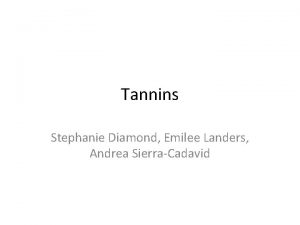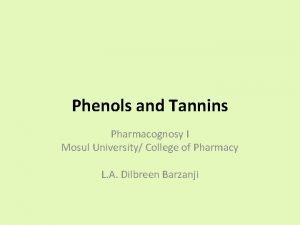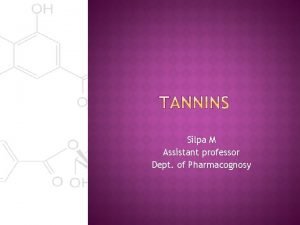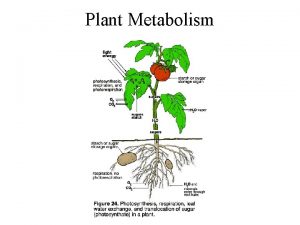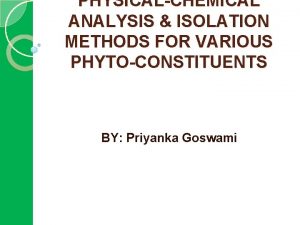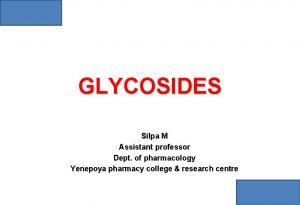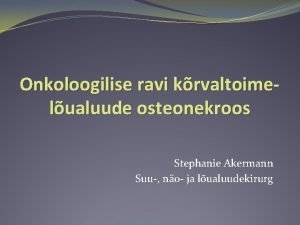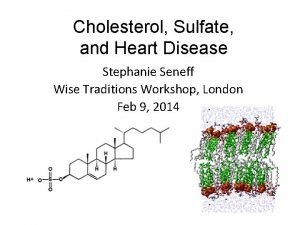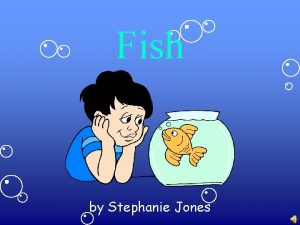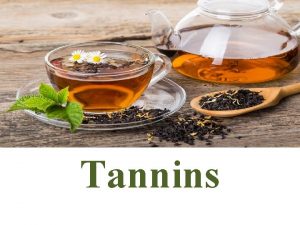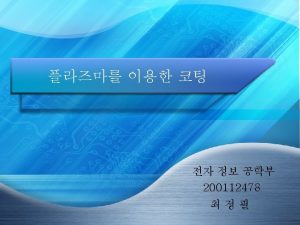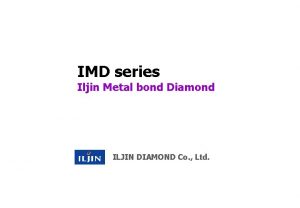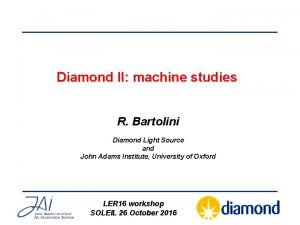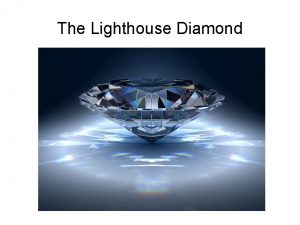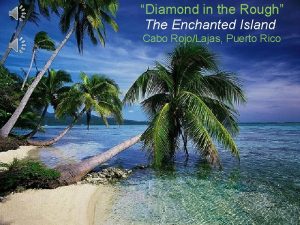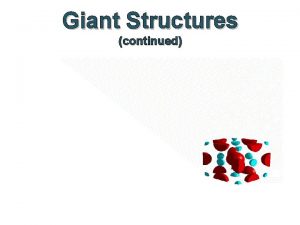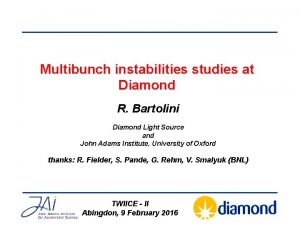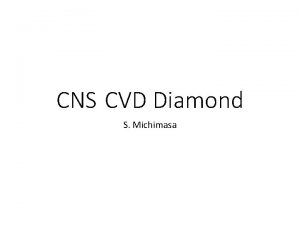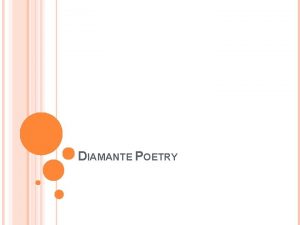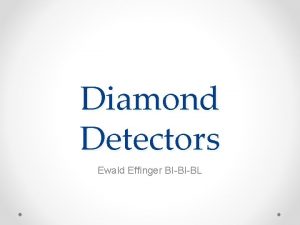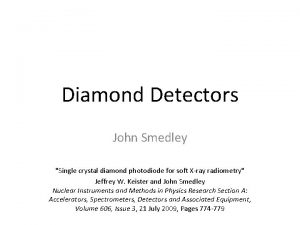Tannins Stephanie Diamond Emilee Landers Andrea SierraCadavid What



























- Slides: 27

Tannins Stephanie Diamond, Emilee Landers, Andrea Sierra-Cadavid

What are tannins? • Large molecular weight phenolic compounds • Condensed and Hydrolyzable chemistry. about. com

Chemistry of Tannins • Hydrolyzable Tannins – Mainly gallic acid and related compounds – Hydrolyzed by acid, alkali, enzymes and hot water • Condensed Tannins – Also called proanthocyanins – Polymerized flavan-3 -ols E. Haslam / Chemistry of Vegetable Tannins. (1966) Fao. org

Chemistry of Tannins • Astringency – Tannins bind carbohydrates and proteins and become insoluble – “roughness” mouthfeel • Antioxidants – – Free-radical scavengers Highly reactive phenols Prevents oxidation Lowers risk of CVD and cancer • Prooxidants – As with any antioxidant, at high levels can act as a prooxidant. E. Haslam / Chemistry of Vegetable Tannins. (1966)

Consumption of Tannins • Ubiquitous nature in foods – Fruits • Berries, pomegranate, persimmons, and more. – Nuts – Herbs and Spices – Beverages • Tea and wine • Consumption estimated between 1 and 1. 1 g/day – Potential to be a main source of antioxidant in the human diet • Traditionally used in herbal medicines and teas

Tannins as an anti-nutrient • Reduces the nutritional value of a food – Inhibition of digestive enzymes (due to protein binding ability) – Reduction in bioavailability of iron, vitamin A and B 12 • Anti-nutrient activity found only in in-vitro studies • Inhibition not thoroughly understood – Caused by tannins or other mechanisms? – Absorption affected by glycosylation, conjugation, size, degree of polymerization, solubility • Contradictory research – Bioavailability of iron in high and low tannin foods essentially the same L. Bravo / Nutrition Reviews (1998)

Tannins as Carcinogens • Oral cancer – Betel nuts, containing 20% tannins • Esophageal cancer – Associated with hot tea consumption – May have actually been associated with the temperature of the water • Prevailing sentiment: Tannins exhibit primarily health-promoting properties. L. Bravo / Nutrition Reviews (1998)

Tannins in Nuts • Nuts more widely known for other health-promoting properties – High in unsaturated fatty acids – Cholesterol lowering • Condensed tannins – Almonds and hazelnuts • Hydrolyzable tannins – Walnuts Nutstop. com • Current research on nuts and tannins almost entirely quantification • Karamać (2009) looked at levels of antioxidant activity related to tannins in nuts – Walnuts > hazelnuts > almonds • Huge research potential for nuts M. Karamać / Eur. J. Lipid Sci. Technol. (2009)

Berries Popular in USA Popular in other countries Exotic berries

Berries • Highly nutritious fruit: Vit A and Vit C Ca, Fe, Mg • Good source of dietary fiber • High content of antioxidant compounds Schwartz and others 2008 N. P. Seeram NP / J. Agric. Food Chem. 56 (2008) 627– 629

Tannins in Berries Different types of phytochemicals: One of the most important ones are TANNINS Condensed: Proanthocyanidins Hydrolyzables: ellagitannis and gallotannis N. Seeram et al. / Separation and Purification Technology 41 (2005) 49– 55

Tannins in Berries Bioavailability reported to be low!! BUT Addison Wesley Longman Inc N. P. Seeram / J. Agric. Food Chem. 56 (2008) 627– 629

Tannins in Berries Type of tannins varies according to the specific berry and give each berry a different beneficial effect. • Proanthocyanidins: Cranberries and blueberries. • Ellagitannins: Strawberries, cloudberries and raspberries.

Tannins in Berries Proanthocyanidins from blueberry act on striatum of the brain helping to keep the memory function while ageing. http: //www. brainwaves. com/ Ellagitannins from strawberry act on hippocampus of the brain reducing the effect of aging on spatial orientation. B. Shukitt-Hale B et al. / Neurobilogy of Aging, 20 (2007) 1187 -1194.

Tannins in Berries Proanthocyanidins from Cranberry have a protective effect against urinary track infections Gunraj S. 2013 A. B. Howell / Critical Reviews in Food Science and Nutrition, 42 (2008) 273 -278

Tannins in Berries http: //www. turbosquid. com/3 d-models/3 d-maxescherichia-coli-e/316273 R. Puupponen-Pimiä et al. / J. Applied Microbiology 98 (2005) 991– 1000. Ellagitannins from cloudberry and raspberry may reduce the incidence of some foodborne diseases.

Tannins in Berries Copeland 2013 M. Shukla et al. / Nutrition 24 (2008) 733– 743 Ellagitannins from pomegranate may work as preventive agents for Arthritis Rheumatoid and Osteoarthritis Block the signal transduction pathways and the response of pathogenic cells

Tannins in Berries Punicalagin an ellagitannin from pomegranate, inhibits cyclooxygenase enzyme COX-2, protein kinase B (AKT) and the nuclear factor kappa-B (NFκB) mechanism in colon cells. L. S. Adams et al. / J. Agric. Food Chem. 54 (2006) 980 -985

Red Wine Tannins • Belongs to Non-hydrolyzable group • Condensed tannin (aka proanthocyanidins) source is from grapes – Skins: prodelphinidins and procyanidins – Seeds: only procyanidins Gomez-Plaza E, Hernandez- Jimenez A, Bautista-Ortin AB. 2011. Proanthocyanindins in Grapes and Wine: A Review. In: Petridis GK (editor). 2011. Tannins: Types, Food Containing, and Nutrition. Hauppauge, New York: Nova Science Publishers. 161 -185 p. Images from: www. nature. com and www. intechopen. com

Red Wine Tannins • Contains 1. 2 -4. 4 g of condensed tannins per liter • Amount of tannins depends on various attributes – Fermentation of skins and seeds – Solubility of tannins – Maceration time – Calculate contribution Berdanier CD. 1998. CRC Desk Reference for Nutrition. Boca Raton, Florida: CRC Press LLC. 321 p. Gomez-Plaza E, Hernandez- Jimenez A, Bautista-Ortin AB. 2011. Proanthocyanindins in Grapes and Wine: A Review. In: Petridis GK (editor). 2011. Tannins: Types, Food Containing, and Nutrition. Hauppauge, New York: Nova Science Publishers. 161 -185 p.

Red Wine Tannins • Health benefits – Antioxidant/cancer prevention • Scavenge free radical, chelate transition ions – Cardiovascular disease prevention • Lowers plasma cholesterol levels, inhibits oxidation of LDLs, prevent blood clots • Bioavailability – 34 mg catechin/120 m. L red wine, and 0. 072µM was the max concentration in human plasma – Due to larger structure that can bind other materials, believe that condensed tannins are better absorbed in the large intestine • Colon microbiota Gomez-Plaza E, Hernandez- Jimenez A, Bautista-Ortin AB. 2011. Proanthocyanindins in Grapes and Wine: A Review. In: Petridis GK (editor). 2011. Tannins: Types, Food Containing, and Nutrition. Hauppauge, New York: Nova Science Publishers. 161 -185 p. Serrano J, et al. / Molecular Nutrition and Food Research. 53: 310 -329. Donovan JL, et al. /British J. Nutrition. 87: 31 -37.

Tea Tannins • Green Tea – Fresh leaves that are steamed or pan-fried, then dried to deactivate enzymes • Black Tea – Withered leaves are crushed and polyphenol oxidase can act on the catechins and gallocatechins to form oligomeric theaflavins and polymeric thearubigens Babich H, Gottesman RT, Liebling EJ, Schuck AG. 2008. Theaflavin-3 -gallate and Theaflavin-3'-gallate, Polyphenols in Black Tea with Prooxidant Properties. Basic & Clinical Pharm & Tox. 103: 66 -74.

Tea Tannins • Epidemiological studies: drinking tea regularly – Reducing risk for diseases (cancer & CVD) even subject is constantly exposed to toxic substances (consuming alcohol and smoking) • Bioavailability – Flavon-3 -ol in green tea = 39% bioavailability in humans – Great differences in excretion, this may be due to difference in participants’ microbiota Smiechowska M, Dmowski P. 2011. Influence of Selected Factors on the Content of Tannins in Tea Extracts. In: Petridis GK (editor). 2011. Tannins: Types, Food Containing, and Nutrition. Hauppauge, New York: Nova Science Publishers. 161 -185 p. Zhu M et al. /Planta medica 66: 444 -447. Del Rio D at al. / Nutrition 26: 1110 -1116.

Persimmon • Belong to non-hydrolyzable group of tannins • Specific repeating units to form tannins within persimmons – Catechin-3 -gallate – Gallocatechin-3 -gallate Besada C, Salvador A. Tannins of Persimmon Fruit: Artificial Removal of Astringency. In: Petridis GK (editor). 2011. Tannins: Types, Food Containing, and Nutrition. Hauppauge, New York: Nova Science Publishers. 217 -230 p.

Persimmon • Health benefits – Antioxidant activity – Anti-inflammatory activity – Hypolipidemic activity – Enzyme inhibiting – Detoxification of snake venom • Structure cause for health benefits – Monomeric flavan-3 -ol units – Types of interflavan bonds – Degree of polymerization Li et al. / Acta Horticulturae 996: 455 -466. Images from: en. wikipedia. org

Conclusion • Large molecular weight phenolic compounds – Two categories: Condensed and Hydrolyzable • Wide variety of health benefits – Antioxidants – Lowers risk of CVD and cancer • Found in a large variety of foods and beverages • Further research is needed – Understand benefits and possible risks as an anti -nutrient – Understand bioavailability • Colon microbiota

Thank you Questions?
 Criteria of choosing brand elements
Criteria of choosing brand elements Mrs landers
Mrs landers Landers earthquake
Landers earthquake Https://www.youtube.com/watch?
Https://www.youtube.com/watch? Andrea sierra cadavid
Andrea sierra cadavid Tannins pharmacognosy
Tannins pharmacognosy Gelatin test for tannins
Gelatin test for tannins What is tannin
What is tannin Test for tannins
Test for tannins Glycosides examples
Glycosides examples Old nzvy
Old nzvy Stephanie akermann
Stephanie akermann Stephanie jean philippe
Stephanie jean philippe Usenet message stephanie
Usenet message stephanie Dr hahusseau stéphanie
Dr hahusseau stéphanie Stephanie seneff cholesterol
Stephanie seneff cholesterol Stephanie husan
Stephanie husan Stephanie budd
Stephanie budd Machismo examples
Machismo examples Dr stephanie reese
Dr stephanie reese Stephanie barger
Stephanie barger El verbo
El verbo Was invented by stephanie kwolek in 1966
Was invented by stephanie kwolek in 1966 Stephanie tompkins
Stephanie tompkins Signing naturally 5:6
Signing naturally 5:6 Stephanie jones
Stephanie jones Interpreting the remainder
Interpreting the remainder Stephanie droker
Stephanie droker




